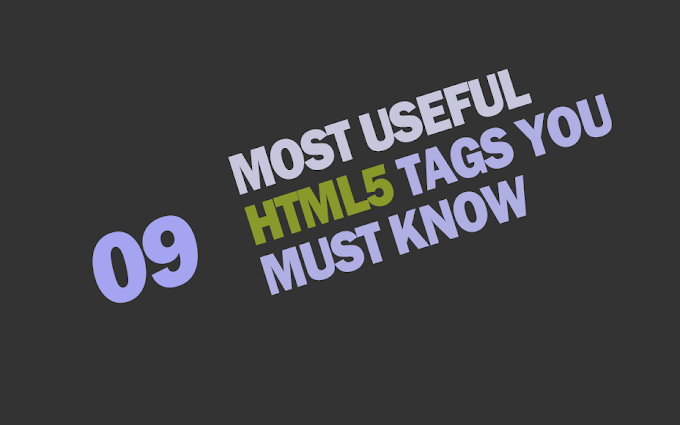HTML5 is the latest version of the standard that defines HTML. Some of the new elements are discussed below.
<progress>
<progress> tag is used to show a progress bar.
Example
<!DOCTYPE html>
<html>
<body>
<label for="file">Uploading:</label>
<progress id="file" value="50" max="100"> 50% </progress>
</body>
</html>
Result
<details>
<details> tag used for additional information. The user has the option to view or hide this.
Example
<!DOCTYPE html>
<html lang="en">
<head>
<meta charset="UTF-8">
<meta name="viewport" content="width=device-width, initial-scale=1.0">
<title>Aside</title>
<style>
details {
width: 20%;
}
summary,
p {
background: blueviolet;
color: #fff;
padding: 10px;
}
</style>
</head>
<body>
<details>
<summary>Wikipedia</summary>
<p>Wikipedia is a multilingual open-collaborative
online encyclopedia created and maintained by a community of
volunteer editors using a wiki-based editing system.
It is one of the 15 most popular websites as ranked by
Alexa, as of August 2020.</p>
</details>
</body>
</html>
Result
<header>
<header> tag specifies the webpage header. It also is used for objects inside the webpage. It is a block element.
Example
<header>
<h1>Post Title</h1>
<p>Article by John.</p>
</header>
<footer>
<footer> tag specifies the webpage footer. It also is used for objects inside the webpage. It is also block element.
Example
<footer>
<h5>© Copyright 2021 Company Name. All rights reserved.</h5>
<p><a href="mailto:example@example.com">example@example.com</a></p>
</footer>
<main>
<main> tag specifies the main content of the webpage.
Example
<main>
<h5>Lorem ipsum dolor sit, amet consectetur adipisicing elit.</h5>
<p>Accusantium error incidunt voluptatum quia cum perspiciatis ut voluptates consectetur minus adipisci.</p>
</main>
<article>
<article> tag denotes independent content. It doesn't render any special in a browser. But it is used to style the block.
Example
<article>
<h1>article title</h1>
<p>writer name</p>
</article>
<aside>
<aside> tag denotes content displayed in a sidebar of the webpage. It doesn't render any special in a browser.
Example
<!DOCTYPE html>
<html lang="en">
<head>
<meta charset="UTF-8">
<meta name="viewport" content="width=device-width, initial-scale=1.0">
<title>Aside</title>
<style>
aside{
display: inline-block;
width: 20%;
background: #ddd;
padding: 10px;
}
</style>
</head>
<body>
<h1>This is title</h1>
<aside>Lorem ipsum dolor sit amet consectetur adipisicing elit. Minus eius dolorem et optio, porro impedit culpa
illo id nisi reprehenderit numquam ducimus voluptatem minima pariatur? Nobis aperiam provident deserunt eos!
</aside>
</body>
</html>
Result

<section>
<section> tag specifies a particular section in the webpage.
Example
<!DOCTYPE html>
<html lang="en">
<head>
<meta charset="UTF-8">
<meta name="viewport" content="width=device-width, initial-scale=1.0">
<title>Aside</title>
<style>
</style>
</head>
<body>
<section>
<h1>Lorem ipsum dolor sit amet consectetur, adipisicing elit.</h1>
<p>
Lorem ipsum dolor sit amet consectetur adipisicing elit.
Placeat eum fugiat sapiente voluptatum molestias?
Maxime possimus veritatis nesciunt sit? Deleniti
labore perferendis maiores corporis error consequatur
necessitatibus eius dolore distinctio.
</p>
</section>
<section>
<h1>Lorem, ipsum dolor sit amet consectetur adipisicing elit.</h1>
<p>
Lorem ipsum dolor sit amet consectetur adipisicing elit.
quam veniam in architecto voluptates quisquam laudantium!t
veritatis
sit.
</section>
<section>
<h1>Lorem ipsum dolor sit amet consectetur, adipisicing elit. </h1>
<p>Lorem ipsum dolor sit amet, consectetur adipisicing elit.labori
quaerat ut qui perferendis, quisquam eligendi
tempore!</p>
</section>
</body>
</html>
Result
<dialog>
<dialog> tag is used to create dialog box. The open attribute specifies that the dialog element is active and that the user can interact with it.
<!DOCTYPE html>
<html lang="en">
<head>
<meta charset="UTF-8">
<meta name="viewport" content="width=device-width, initial-scale=1.0">
<title>Aside</title>
<style>
body{
text-align: center;
}
dialog {
width: 20%;
}
</style>
</head>
<body>
<h5>Dialog box </h5>
<dialog open>Wikipedia is a multilingual open-collaborative
online encyclopedia created and maintained by a community of
volunteer editors using a wiki-based editing system.
It is one of the 15 most popular websites as ranked by
Alexa, as of August 2020.</dialog>
</body>
</html>
Result













![[Cupons] Paid udemy courses for free](https://blogger.googleusercontent.com/img/b/R29vZ2xl/AVvXsEgYa-f_8UEE95d9stpdRzq6_DUq19avn09M2CVWIuQGI_PwaZBMcNhuHmPZQsw81GMeWwUY2Q-Cr66RoAmMq1f_pok6pdv-W86qc9_wWSxqXEq_RHYyRY0Ldly_yi2DSfyed4Cxiks6Nbzp/w680/Paid+udemy+courses+for+free.png)



0 Comments
If you have any question please ask?